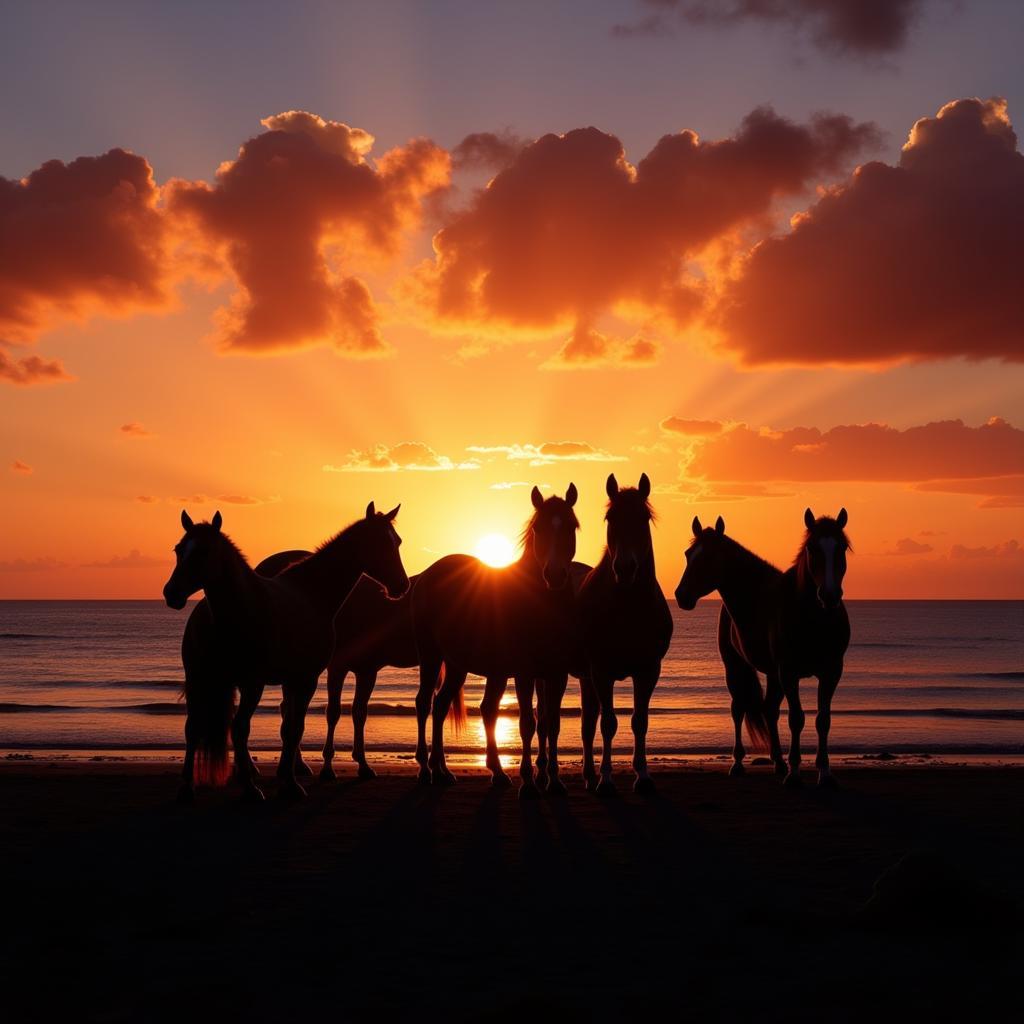Wild horses galloping along the pristine beaches of Amelia Island, Florida, are a captivating sight. This article delves into the history, ecology, and current conservation efforts surrounding these majestic creatures, offering a comprehensive guide for anyone eager to learn more about these iconic inhabitants of Amelia Island.
Discovering the Wild Horses of Amelia Island
Amelia Island’s wild horses are a unique part of Florida’s coastal ecosystem. They are descendants of domesticated horses brought over by Spanish explorers centuries ago. Over time, some of these horses escaped or were released, forming feral herds that adapted to the island environment. These resilient animals have become a symbol of the island’s wild beauty and a source of fascination for visitors and locals alike. Their presence contributes to the rich biodiversity and adds a touch of untamed spirit to the island’s landscape. Understanding their history and behavior is key to appreciating their role in this delicate ecosystem.
The Ecology and Behavior of Amelia Island’s Wild Horses
These wild horses are not simply beautiful; they are integral to the island’s ecological balance. They graze on the island’s vegetation, helping to maintain the diverse plant life and prevent overgrowth. Their grazing patterns also contribute to seed dispersal and influence the structure of the island’s habitats. Observing their social dynamics reveals a complex hierarchy within the herd, with a lead mare often guiding the group. Understanding their behavior is crucial for respecting their space and ensuring their continued well-being.
What do the wild horses eat on Amelia Island?
The wild horses on Amelia Island primarily graze on a variety of grasses, shrubs, and other vegetation found within their habitat. Their diet can vary seasonally depending on the availability of different plant species.
Conservation Efforts and Responsible Tourism
The long-term survival of the wild horses depends on careful management and responsible tourism. Local organizations work tirelessly to protect these animals, monitoring their health, managing their population, and educating the public. Visitors are encouraged to admire the horses from a safe distance, refraining from feeding or interacting with them directly. These practices help maintain the horses’ wild nature and preserve the delicate balance of the island ecosystem. Supporting these conservation efforts ensures that future generations can continue to witness the splendor of these wild creatures roaming free.
How can I help protect the wild horses?
By supporting local conservation organizations and adhering to responsible wildlife viewing guidelines, you can contribute to the protection of the wild horses on Amelia Island.
The Future of Wild Horses on Amelia Island
The future of Amelia Island’s wild horses relies on the continued dedication of conservationists, researchers, and the public. Ongoing research helps us understand the horses’ impact on the environment and develop sustainable management strategies. Public awareness and responsible tourism play a vital role in ensuring the long-term survival of these iconic animals. By working together, we can protect this unique piece of Florida’s natural heritage.
 Wild Horses at Sunset on Amelia Island
Wild Horses at Sunset on Amelia Island
Conclusion
The wild horses of Amelia Island, Florida, are more than just a picturesque sight; they represent a living link to the island’s history and a vital component of its ecosystem. By understanding their story, respecting their space, and supporting conservation efforts, we can ensure that these magnificent animals continue to grace the island’s shores for generations to come.
FAQ
- Are the horses truly wild? Yes, these horses are considered feral, meaning they are descendants of domesticated animals that now live in the wild.
- Can I feed the horses? No, feeding the horses is discouraged as it can disrupt their natural foraging behavior and create health problems.
- How many wild horses are on Amelia Island? The population fluctuates, but it is generally managed to maintain a sustainable number.
- What should I do if I encounter a horse on the beach? Admire it from a distance and do not approach or attempt to interact with it.
- How can I learn more about the horses? Local organizations and visitor centers offer information about the history and ecology of the wild horses.
- Where can I see the wild horses on Amelia Island? The horses tend to roam freely, but they are often spotted on the beaches and in the marshes.
- Are there guided tours to see the wild horses? Yes, several tour operators offer guided tours specifically focused on viewing the wild horses responsibly.
Need Help with Your Own Horses or Pets?
When you need support, please contact us: Phone Number: 0772127271, Email: [email protected] or visit us at: QGM2+WX2, Vị Trung, Vị Thuỷ, Hậu Giang, Việt Nam. We have a 24/7 customer service team.